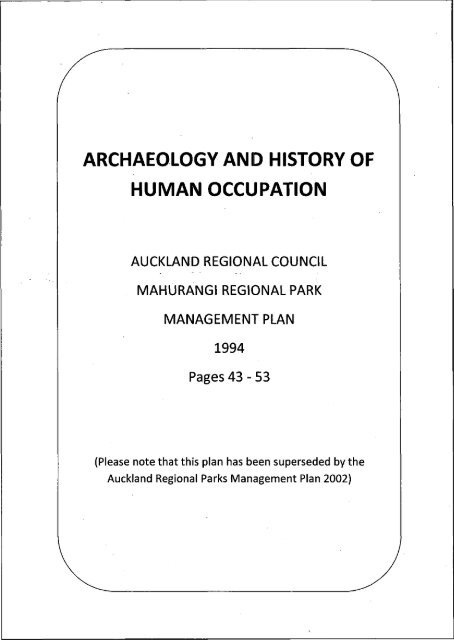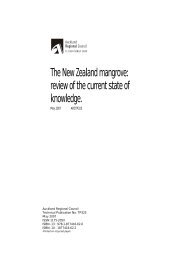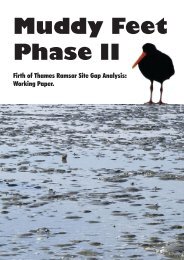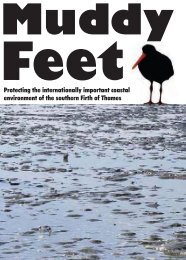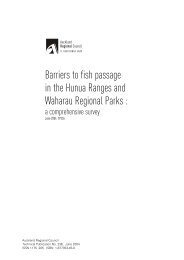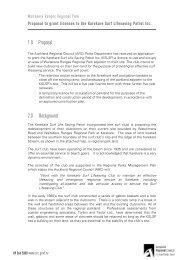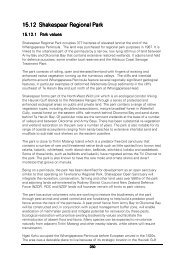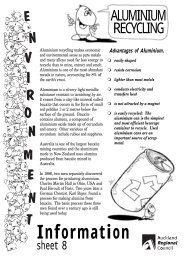archaeology and history of human occupation - Auckland Regional ...
archaeology and history of human occupation - Auckland Regional ...
archaeology and history of human occupation - Auckland Regional ...
You also want an ePaper? Increase the reach of your titles
YUMPU automatically turns print PDFs into web optimized ePapers that Google loves.
ARCHAEOLOGY AND HISTORY OF<br />
HUMAN OCCUPATION<br />
AUCKLAND REGIONAL COUNCIL<br />
MAHURANGI REGIONAL PARK<br />
MANAGEMENT PLAN<br />
1994<br />
Pages 43 - 53<br />
(Please note that this plan has been superseded by the<br />
Auckl<strong>and</strong> <strong>Regional</strong> Parks Management Plan 2002)
43<br />
Extensive intertidal rock platforms from the most to least exposed occur <strong>of</strong>fCudlip<br />
Point, Big Bay, Te Muri headl<strong>and</strong> <strong>and</strong> Tungutu Point. These are characterised by<br />
a mixture <strong>of</strong> coralline turf, Corallina <strong>of</strong>ficinalis, <strong>and</strong> Neptune's necklace seaweed<br />
Hormosira banksii, along with occasional small green-lipped mussels, Perna<br />
canaliculus near the low tide mark, with rock oysters Saccostrea glomerata <strong>and</strong><br />
Pacific oysters, Crassostrea gigas, near the mid tide mark.<br />
The most common intertidal species on this coast include oyster borer Lepsiella<br />
scobina, black rock snail Nerita atramentosa, snakeskin chiton Sypharochiton<br />
pelliserpentis, barnacle Chamaesipho columna <strong>and</strong> the half crab Petrolisthes<br />
elongates. Although small, the numbers <strong>of</strong> intertidal kina increased with<br />
increasing difficulty <strong>of</strong> access. This trend has been found at several regional<br />
parks.<br />
In the Te Muri Estuary, mud snails Amphibola crenata graze algae on the mud<br />
surface, <strong>and</strong> mud crabs Helice crassa form numerous burrows.<br />
Mahurangi Harbour, with its complex coastline, displays a wide range <strong>of</strong> habitats<br />
within a small distance. Many <strong>of</strong> these habitats are found within 800m seaward <strong>of</strong><br />
the park's foreshore boundary.<br />
ARCHAEOLOGY<br />
Maori <strong>occupation</strong> <strong>of</strong> Mahurangi was intensive, as indicated by the wealth <strong>of</strong><br />
archaeological sites. The majority <strong>of</strong> these sites are well preserved <strong>and</strong> could<br />
provide an outst<strong>and</strong>ing feature for interpretation.<br />
An archaeological survey <strong>of</strong> Mahurangi West was carried out by Fox (1980) <strong>and</strong><br />
by the.N.Z Archaeological Association (1.98.1). 25 sites were recorded, over half<br />
<strong>of</strong> which were midden. Te Muri Beach was surveyed by Rickard (1985), <strong>and</strong> by<br />
Lawlor (1991). The remaining sites were re-surveyed by Lawlor (1993).<br />
Mahurangi East was subject to a brief reconnaissance by Lawlor (1991) <strong>and</strong> in<br />
more detail by Clough (1993). Site records are held by the New Zeal<strong>and</strong><br />
Archaeological Association Filekeeper, C/- Department <strong>of</strong> Conservation.<br />
Mahurangi West<br />
Pa sites are located on Opahi Point, behind Otarawao/Sullivan Bay on a hill<br />
adjacent to the road approach <strong>and</strong> opposite the woolshed, on Cudlip Point <strong>and</strong> Te<br />
Muri Point.<br />
The Opahi pa is defended by a large traverse ditch <strong>and</strong> bank as well as extensive<br />
terraces. A series <strong>of</strong> old tracks access the ridge <strong>and</strong> Opahi Bay. The site is in<br />
long grass. ;<br />
The Otarawao pa is defended by natural scarps <strong>and</strong> terraces which follow the hill<br />
contours. Transverse ditches run between lateral scarps. Part <strong>of</strong> this pa has been<br />
damaged by the road <strong>and</strong> by a bulldozed track. The pa extends into the adjacent<br />
property. A farm track follows an extensive terrace. .•
44<br />
The Cudlip Point pa-follows the narrow saddle on the headl<strong>and</strong> ridge. Part in<br />
grass <strong>and</strong> part in bush, a formed bush track me<strong>and</strong>ers around numerous pits. The<br />
pits are kept cleared <strong>of</strong> grass <strong>and</strong> are an excellent interpretation feature.<br />
Te Muri Point pa is the most extensive <strong>of</strong> all four sites, also part in grass, part in<br />
bush. The outer grassed zone is defended by ditches, <strong>and</strong> the inner bush zone <strong>of</strong><br />
pits is defended by transverse ditches <strong>and</strong> terraces. The original walking track to<br />
the pa remains.<br />
v<br />
Mahurangi East<br />
This area was surveyed by Clough (1993) <strong>and</strong> Lawlor (1991). 18 sites were<br />
recorded. Pits, terraces <strong>and</strong> midden were located on the ridge behind Big Bay, <strong>and</strong><br />
on the slopes <strong>and</strong> ridges <strong>of</strong> Poplar Bay. Other sites present on Mahurangi Head<br />
include a well preserved ,pa (Davidson 1961), which is not located on parkl<strong>and</strong>.<br />
Occasional middens occur around the coast. Sites <strong>of</strong> historic interest include old<br />
ship-building yards <strong>and</strong> a post-war woolshed at Poplar Bay <strong>and</strong> the old<br />
Kaukapakapa schoolhouse at Big Bay.<br />
Scott Point<br />
This area was surveyed by Clough (1993). 4 sites were recorded, including pits,<br />
terraces, a ditch <strong>and</strong> a midden. Several surveys have also been undertaken in the<br />
immediate area (Morwood 1975, Nicol 1977, Walton 1976). These surveys<br />
showed that most <strong>of</strong> the headl<strong>and</strong>s around the mouth <strong>of</strong> the Mahurangi harbour<br />
were pa sites. A pa site is located on Casnell Isl<strong>and</strong>. Archaeological evidence at<br />
Scott Point is associated with this. Scott Homestead is a site <strong>of</strong> historic interest.<br />
A feature <strong>of</strong> the Mahurangi area as a whole is that there are few pits <strong>and</strong> sites tend<br />
to be coastal rather than inl<strong>and</strong>. This reflects the importance <strong>of</strong> the Mahurangi<br />
harbour as a source <strong>of</strong> kaimoana (seafood). The lack <strong>of</strong> pits suggests little need<br />
for cultivation <strong>and</strong> seasonal use <strong>of</strong> the area.<br />
HISTORY OF HUMAN OCCUPATION<br />
The early Maori <strong>history</strong> <strong>of</strong> the Mahurangi area is complex. The name Mahurangi<br />
once referred to the very large area <strong>of</strong> l<strong>and</strong> from Te Arai to Takapuna sold to the<br />
Crown in 1841, but now denotes the area from Snells Beach down to the Puhoi<br />
Estuary.<br />
It appears that the earliest occupiers <strong>of</strong> the l<strong>and</strong> were the Kawerau tribe - part <strong>of</strong><br />
the great Ngaohp people occupied all the l<strong>and</strong>s from the Brynderwyn Hills<br />
southwards to Bombay. Over time Ngaoho divided themselves informally into<br />
groups in particular areas - those north <strong>of</strong> Waitemata were the "Kawerau 1 . In the<br />
Whangateau to Orewa area, hapu <strong>of</strong> the Kawerau were Ngatikahu<br />
Ngatipoataniwha.<br />
The Maori regarded the l<strong>and</strong> as being part <strong>of</strong> the people - with the emphasis not on<br />
ownership but more on 'rights' <strong>of</strong> <strong>occupation</strong> or use. The coastal strip <strong>of</strong> parkl<strong>and</strong><br />
included in Mahurangi West provided good natural resources, fishing in the<br />
sheltered tidal waters between the isl<strong>and</strong>s <strong>and</strong> in the bay, shellfish gathering on the<br />
rocky <strong>and</strong> s<strong>and</strong>y shores, eels in the streams, birds in the bush inl<strong>and</strong> <strong>and</strong> kumara<br />
cultivations on the better drained soils on slopes <strong>and</strong> alluvial beach flats. A number
45<br />
<strong>of</strong> sites provided good scope for defended positions <strong>and</strong> canoe travel was possible<br />
across the Hauraki Gulf, amongst the isl<strong>and</strong>s <strong>and</strong> up the estuary.<br />
In the 1820's after the battle <strong>of</strong> Te Ika-a-ranga-nui at Kaiwaka, in which Hongi<br />
Hika's party from the north (nearly all armed with muskets) massacred hundreds <strong>of</strong><br />
Ngati Whatua, there was a scattering <strong>of</strong> people <strong>of</strong> the east coast areas leaving the<br />
l<strong>and</strong> between North Kaipara <strong>and</strong> the Tamaki desolate. Te Hemara Tauhia <strong>of</strong> the<br />
Kawerau, chief <strong>of</strong> the l<strong>and</strong> at Mahurangi West went to live with Pomare II <strong>of</strong> the<br />
Ngapuhi probably because <strong>of</strong> kinship (Te Hemara may have been young at this<br />
time). Others fled to the Waikato. Percy Smith relates (1910) "The old men have<br />
<strong>of</strong>ten described to me the state <strong>of</strong> fear <strong>and</strong> alarm they lived in during their wild life<br />
in the mountains <strong>and</strong> forests, they rarely approached the river or path but confined<br />
themselves to the wild bush living on eels, birds <strong>and</strong> produced <strong>of</strong> a few hidden<br />
cultivations".<br />
During the Kawerau absence, the Ngati Paoa <strong>of</strong> the Hauraki Gulf who had long<br />
claimed fishing rights in Mahurangi, about 1833 established themselves on the<br />
coast. It seems the absence <strong>of</strong> the Kawerau allowed the Ngati Paoa to consider<br />
they had a right to sell the l<strong>and</strong>, <strong>and</strong> in 1841 the whole Mahurangi Block from te<br />
Arai to Takapuna <strong>and</strong> from the coast inl<strong>and</strong> to the dividing range was sold to the<br />
Government. Due to the dispute over the original ownership <strong>of</strong> the l<strong>and</strong> the<br />
Government was obliged to pay twice for most <strong>of</strong> the Mahurangi Block.<br />
Te Hemara claimed a large area <strong>of</strong> the Mahurangi Block <strong>and</strong> his claim was<br />
approved by Commissioner Johnson who wrote "he has with his party, numbering<br />
about 100 individuals no other place to reside on, <strong>and</strong> the whole <strong>of</strong> the natives in<br />
the country are convinced <strong>of</strong> his right to what he claims, which I have prevailed<br />
upon him to curtail to the extent delineated in the plan, consisting <strong>of</strong> timberl<strong>and</strong>,<br />
no part <strong>of</strong> which can be said to be available for the location <strong>of</strong> European Farmers".<br />
With thous<strong>and</strong>s <strong>of</strong> settlers arriving good farming l<strong>and</strong> was highly sought after <strong>and</strong><br />
strong pressure was brought to bear on the Maori people to sell <strong>and</strong> this appears to<br />
have been the case in the Mahurangi area. Early in 1854 Native l<strong>and</strong><br />
Commissioner Donald McLean instructed John .Grant Johnson to. "use his utmost ,<br />
exertion to acquire from the natives the whole <strong>of</strong> their l<strong>and</strong>s in this district which<br />
are not essential to their own welfare, <strong>and</strong> that are more immediately required for<br />
the purposes <strong>of</strong> colonisation".<br />
Shortly after the Native L<strong>and</strong> Court was constituted in 1865, investigation <strong>of</strong> title<br />
to the Mahurangi l<strong>and</strong>s was carried out. Blocks included in the present <strong>Regional</strong><br />
Park area included Otarawhao, Nokenoke, Orokaraka <strong>and</strong> parts <strong>of</strong> Puhoi, Tungutu<br />
<strong>and</strong> Opahi.<br />
In gratitude to those who had sheltered the Kawerau people during Hongi's raids,<br />
gifts <strong>of</strong> l<strong>and</strong> were given. In 1856 Opahi had been given to Waikato Maoris. A<br />
small part <strong>of</strong> this block is today the only Maori-owned l<strong>and</strong> in the area, <strong>and</strong> is<br />
known as Waikato Bay. Nokenoke <strong>and</strong> Otarawhao blocks were given to Wiremu<br />
<strong>and</strong> Hare Pomare, sons <strong>of</strong> Pomare H who had sheltered Te Hemara.<br />
The small Orokaraka block which included flats on the Puhoi River was to be<br />
leased to shipbuilders.<br />
One <strong>of</strong> Te Hemara's kaainga was on the s<strong>and</strong>y point at the mouth <strong>of</strong> Te Muri<br />
Stream, <strong>and</strong> Pomare's kaainga was on Nokenoke on the next point up the stream.<br />
Otarawao (Sullivan Bay) Area<br />
Merihi, wife <strong>of</strong> John Sullivan petitioned the Governor for l<strong>and</strong> for her 2 children,<br />
William <strong>and</strong> Julia Sullivan - the children <strong>of</strong> John Sullivan.
46<br />
Sometime during 1870's to 1880's or perhaps earlier, the Crown granted her 300<br />
acres including a bay originally known as Otarawao Bay which means 'haven 1 or<br />
'last refuge <strong>of</strong> shelter' - now also known as Sullivan Bay.<br />
Julia Sullivan married William Benjamin Jackson <strong>of</strong> Dublin <strong>and</strong> they toad 12<br />
children. William, variously a gum merchant, timber merchant <strong>and</strong> shipwright who<br />
lost a lot <strong>of</strong> money in the Waihi Goldmines, took possession <strong>of</strong> the l<strong>and</strong> <strong>and</strong> the<br />
family lived there permanently from the 1880's. The l<strong>and</strong> was cleared by William<br />
<strong>and</strong> his sons for farming, not an easy task <strong>and</strong> as a result two <strong>of</strong> the boys died <strong>of</strong><br />
pneumonia <strong>and</strong> consumption.<br />
A two storeyed kauri house was built but unfortunately it burnt down in 1890.<br />
Another was built, also to be used as a guest house around the turn <strong>of</strong> the century.<br />
The bottom half <strong>of</strong> this house remains in place (now the rangers residence), the top<br />
half was taken two bays north to Opahi for another family member to live in (it<br />
now belongs to the Baptist Church).<br />
Around the turn <strong>of</strong> the century Otarawao Bay was known as Jacksons Bay.<br />
However, in the early 1900's Captain William Sullivan returned to the area with a<br />
young wife <strong>and</strong> family. Finding it hard to settle, his sister Julia had a house built<br />
for them on the hill (the present Senior Ranger's house).<br />
In 1914 Julia (nee Sullivan) died followed by her husb<strong>and</strong> William Jackson in<br />
1917. Since WW I the Sullivan side <strong>of</strong> the family has looked after most <strong>of</strong> the<br />
property - Otarawao Bay by then also known as Sullivan Bay.<br />
Julia Jackson died leaving no will <strong>and</strong> as is the custom the l<strong>and</strong> passed to her eldest<br />
son, Captain John Jackson. He had little interest in the l<strong>and</strong> <strong>and</strong> sold it to his<br />
uncle, William Sullivan, for a small sum on a gentlemen's agreement. It is William<br />
Sullivan's second wife Ngarewa from which Ngarewa Drive takes its name.<br />
The Sullivans kept one end <strong>of</strong> the beach <strong>and</strong> sold the rest to the Schischkas, part <strong>of</strong><br />
which was then sold to a Mr Olsen (Perfection Textiles) <strong>and</strong> the l<strong>and</strong> passed to the<br />
„ ... ...:, Auckl<strong>and</strong> <strong>Regional</strong>Authority in 1968 at a time when applications were being made<br />
by the owner to have it zoned for urban development. Up until 1972 the l<strong>and</strong> was<br />
I leased to Mr Olsen <strong>and</strong> the Schischka. The Authority then appointed a resident<br />
1 staff member to maintain <strong>and</strong> gradually develop the l<strong>and</strong>. The last l<strong>and</strong> bought was<br />
the 15ha Tungutu block completed by 1984.<br />
Otarawao/Sullivan Bay is the site <strong>of</strong> the annual Mahurangi Regatta. The regatta<br />
was first held in 1858 <strong>and</strong> sporadically thereafter. It was revived in 1977 by The<br />
Friends <strong>of</strong> The Mahurangi Inc. <strong>and</strong> (weather permitting) it has been held each year<br />
since on the Saturday <strong>of</strong> the Auckl<strong>and</strong> Anniversary holiday weekend.<br />
Te Muri Area<br />
In 1973, the ARA acquired 120 acres at Te Muri from Mr V Schischka under the<br />
i| Public Works Act. The l<strong>and</strong> included a small cemetery which was part <strong>of</strong> Chief Te<br />
1 Hemara Tauhia's kaainga, about 120 years ago when burials began hi the late<br />
1860's. There are more than a hundred people buried in the 0.2ha graveyard<br />
|f however most <strong>of</strong> the graves are unnamed although some records <strong>of</strong> burial are<br />
available. The two pohutukawa trees are Tapu (sacred).<br />
By decree <strong>of</strong> Chief Te Hemara, European settlers could also be buried as several<br />
had married into the Maori community.<br />
;f A small wooden Anglican Church was established at Te Muri around 1872 with its<br />
i^v.,^ minister the Rev William Pomare, thought to be the first Maori ordained Minister<br />
^ 5f in New Zeal<strong>and</strong>.
$£<br />
m<br />
47<br />
His brother, Henry Pomare, also lived in the area <strong>and</strong> he visited Engl<strong>and</strong> with his<br />
wife in the 1860's. Queen Victoria took a great interest in the couple <strong>and</strong> became<br />
godmother to their son - Albert Victor. .<br />
Up until the 1920's the graveyard was neatly maintained by the local families. It is<br />
possible that the great flu epidemic <strong>of</strong> 1918-19 took toll <strong>of</strong> many members <strong>of</strong> the<br />
kaainga which may have been the reason for its disappearance.<br />
The last portions <strong>of</strong> the l<strong>and</strong> which included the ab<strong>and</strong>oned church, were<br />
purchased by Victor Schischka in the early 1920's. Today only the cemetery<br />
remains. Burials were spasmodic from them on, the last being in 1956 <strong>and</strong> since<br />
1960 it has been closed.<br />
Successive generations <strong>of</strong> Schischkas had farmed the Puhoi block from 1885.<br />
Owing to its isolation from State Highway 1 stock were forded over the Puhoi<br />
River at low tide whilst fertiliser <strong>and</strong> building materials were bought to Te Muri<br />
Beach by barge.<br />
The Schischka cottage at the south end <strong>of</strong> the beach has been removed. The<br />
garage, temporary Franciscan friary bach <strong>and</strong> a small cottage on the bank <strong>of</strong> the<br />
Puhoi River remain. ,<br />
Authority maintenance <strong>and</strong> development <strong>of</strong> the l<strong>and</strong> since 1972 has mainly<br />
involved improving the quality <strong>of</strong> pasture, fencing out large blocks <strong>of</strong> coastal<br />
regenerating forest, tree planting,, provision <strong>of</strong> service <strong>and</strong> farm buildings, limited<br />
facilities for youth camping <strong>and</strong> in 1987 sealing the entrance road.<br />
Scott House (contributed by Dr R H Locker)<br />
By the end <strong>of</strong> 1989, exterior restoration <strong>of</strong> the building known as Scott House (or<br />
Scotts' Hotel) was completed. Work on the interior continues. With its ver<strong>and</strong>ah<br />
back in place, <strong>and</strong> new paintwork, it should grace for years to come, the bay where<br />
it was built, 125.years previously. -There has been a heavy loss <strong>of</strong> old buildings on<br />
the River. In the same year the old Mahurangi church was demolished, after<br />
cyclone Bola had shifted it <strong>of</strong>f its rotten piles. Most <strong>of</strong> the old homesteads have<br />
gone, <strong>and</strong> the wharf collapsed years ago. It is therefore the more gratifying that ;<br />
Scott House, once a focal point <strong>of</strong> life on the River, should survive as a reminder<br />
<strong>of</strong> the old days at the Heads. Conspicuously located on reserve, it will continue to<br />
be a l<strong>and</strong>mark from the River, <strong>and</strong> an attraction to the increasing numbers that :<br />
drive to the end <strong>of</strong> the Mahurangi East Road, or l<strong>and</strong> on its beach.<br />
It should be recorded that it could easily have been otherwise, but for the efforts <strong>of</strong><br />
individuals <strong>and</strong> groups with a keen sense <strong>of</strong> <strong>history</strong>.<br />
When the Auckl<strong>and</strong> <strong>Regional</strong> Authority in March 1971 acquired as reserve the<br />
eight acres, including the derelict hotel, it seemed probable that it would be<br />
demolished. Mr John Male, a resident <strong>and</strong> Rodney councillor, approached the NZ<br />
Historic Places Trust for help in preserving the building. The Trust was<br />
sympathetic but lacked resources. The Auckl<strong>and</strong> Institute <strong>and</strong> Museum, <strong>and</strong> the<br />
Warkworth Town Council expressed support, but it was the Auckl<strong>and</strong> Civic Trust<br />
which came to the rescue, setting up a task force, <strong>and</strong> obtaining a lease on the<br />
building. Friends <strong>of</strong> Mahurangi helped with a clean-up. Since then a small<br />
groups <strong>of</strong> skilled voluntary workers, at first under the late Mrs Margaret Newman,<br />
<strong>and</strong> latterly under Miss Jo Donovan, have worked away quietly, but with
48<br />
' determination, at the formidable task <strong>of</strong> making good more than a century <strong>of</strong><br />
weathering.<br />
The house once had a substantial orchard, occupying most <strong>of</strong> the flat behind. Its<br />
composition was typical <strong>of</strong> the time, as shown by the remnants: gnarled figs, a<br />
thicket <strong>of</strong> quinces, two large but unproductive pear trees, an aged mulberry, <strong>and</strong> an<br />
inferior American grape, run amuck. The removal <strong>of</strong> the dominant privet trees by<br />
Friends <strong>of</strong> Mahurangi is well advanced, <strong>and</strong> a replanting programme has begun.<br />
A <strong>history</strong> <strong>of</strong> the Scott family appears elsewhere, while there is a local tradition that<br />
the present building was a licensed hotel, the family believed otherwise.<br />
According to Dulcie Bailey, gr<strong>and</strong>-daughter <strong>of</strong> Thomas Scott jun.: "Both Thomas<br />
<strong>and</strong> Janet were very strict temperance people <strong>and</strong> deeply religious Anglicans."<br />
After research, I conclude that the family was correct. In brief: Thomas Scott<br />
sen. certainly ran an inn on this site, which was inherited by Thomas Scott jun., but<br />
run by Thomas Short as publican. After its destruction by fire, Thomas jun.<br />
erected a large house, which became a private hotel or boarding house, then<br />
reverted to the family home. The building is the Scott House <strong>of</strong> today.<br />
Thomas Scott <strong>and</strong> his two sons arrived on the River after shipbuilding <strong>and</strong> trading<br />
in the Bay <strong>of</strong> Isl<strong>and</strong>s, Whangarei <strong>and</strong> Auckl<strong>and</strong>. Thomas launched his first cutter<br />
at Mahurangi in 1849, one <strong>of</strong> three built in that year, marking the birth <strong>of</strong> a local<br />
industry. In December 1853 he acquired the eight acres, now Scott Bay. There<br />
he established his home <strong>and</strong> shipyard, <strong>and</strong> soon after, an inn.<br />
In the first election <strong>of</strong> 1857, 18 votes were cast at "Scotts* Inn". The first village<br />
map shows Inn St passing from the beach to Scott St at the back <strong>of</strong> the flat. A<br />
sketch <strong>of</strong> the bay by Charles Heaphy is undated but probably <strong>of</strong> the 1860's. It<br />
shows two single-storeyed buildings. One must be the inn. An old map <strong>of</strong> 1867,<br />
shows two buildings in a dotted enclosure on Lot 43. -<br />
Scotts was the only stopping place for the first steamers, such as the<br />
' Wongawonga', which ran to fixed timetable, rather than to the tides. Thirsty or<br />
hungry passengers, embarking or disembarking, refreshed themselves at the inn. It<br />
also served as the first post <strong>of</strong>fice. In 1862, Thomas Scott jun. was appointed first<br />
postmaster. , < , ' -<br />
Auckl<strong>and</strong>'s Anniversary Weekend 1860, was a gala occasion there: "The<br />
Richmond Inn, a picturesquely situated house kept by'Thos. Scott sen., was<br />
thronged all day by a happy <strong>and</strong> well conducted number <strong>of</strong> holiday makers, who<br />
did ample justice to the good cheer, solid <strong>and</strong> fluid provided for them". (New<br />
Zeal<strong>and</strong>er, 28.1.60). , \ 1 ;V } /' J; '^'^Jr / '<br />
"~'C ,'f ' ? t4i K ~"^ t'-i't '<br />
A provisional licence was granted t<strong>of</strong>Thom^fcott'm 1862. In 1863 the<br />
Licensing Act was passed, <strong>and</strong> in 1864 thejBrst.Official licences were gazetted. In<br />
such rural places (at least 15,mile0y«rqa:d Spm^uckl_<strong>and</strong>), 'bush licences' were<br />
issued at 5 pounds per annum. •< In the meantime'Thomas Scott sen. had left<br />
Mahurangi in 1863 J <strong>and</strong> died in^AuqWMd^m^Sej^if seems that Thomas jun. .<br />
inherited the property, but a famUy ,fnen||rh;qmas;Sh6rt; had taken over the<br />
running <strong>of</strong> both hotel <strong>and</strong> sWpyard^xShMwas^fifst gazetted holder <strong>of</strong> a bush<br />
„ * & A v~ * v « ' * -'<br />
^x •** / -/• ><br />
'*>•
49<br />
licence for the 'Richmond Inn, Mahurangi 1 , 1864-6. It was also know as the<br />
'Richmond Arms'. Short became postmaster at the same time. His brother Ben<br />
drowned in 1869, putting an end to their shipbuilding partnership. The inn burned<br />
in the early 1870's, an event which would have terminated the licence. By 1873,<br />
Thomas Short had gone back to being a master mariner.<br />
Some four years later, the burned building was replaced by the beginning <strong>of</strong> the<br />
present building:<br />
"Mr Scott is erecting a large two-storied house in what is know as Scotts 1 Bay, on<br />
what was formerly the site <strong>of</strong> the well-known Mahurangi Hotel, <strong>and</strong> which was a<br />
few years since destroyed by fire <strong>and</strong> by which Mr Scott become a heavy loser".<br />
(W.N. 3.2.77).<br />
A reporter in February 1881 noted the completion <strong>of</strong> a fine new wharf, <strong>and</strong> a<br />
"large hotel" by Mr Scott. Next year it was announced: .:<br />
"Mr Thomas Scott has opened a private boarding house at his premises at<br />
Mahurangi Heads, formerly the Mahurangi Hotel, where owing to its proximity to<br />
the Hot Springs (four miles) no doubt he will do a fair trade". (W.N. 16.9.82).<br />
It was probably at this time that the present building was enlarged from a home to<br />
an accommodation house. (The join is obvious on the back wall). Thomas had<br />
gone back to sea, as master <strong>of</strong> s.s/Corom<strong>and</strong>el'. Running the place fell to Mrs<br />
Scott. 'Wise's Directory 1883-4' lists for Mahurangi: "Mrs T Scott, boarding<br />
house". Shortly afterwards the whole family moved to Auckl<strong>and</strong>, a more<br />
convenient residence for the captain. The house was leased, continuing as a<br />
boarding house. In 1908-9 (<strong>and</strong> probably earlier) the lessees <strong>and</strong> hosts were Mr<br />
Angus Grant (son <strong>of</strong> settler James Grant) <strong>and</strong> Mrs Grant.<br />
In the meantime the licence had gone elsewhere. On 1 February 1879, James<br />
"> Watt Darroch, former shipbuilder <strong>of</strong> Marriage Bay, who then described himself as<br />
storekeeper, applied for a bush licence. Licences were then determined locally by<br />
the Mahurangi Licensing Court which sat quarterly in Warkworth <strong>and</strong> consisted <strong>of</strong><br />
3-4 prominent local citizens. The Commissioners (in this case J. Hudson, W<br />
/ Pulham<strong>and</strong>M Angove) sat on 2 June 1879. According to the Weekly News: "J<br />
W Darrach applied for a new license for his house, situated at Mahurangi Heads.<br />
There being no objection the license was granted". (The spelling mistake in the<br />
surname led Mabbett in' The Rock <strong>and</strong> the Sky', to attribute the license to John<br />
Darrach. This was an unfortunate error, since John was early a Son <strong>of</strong><br />
Temperance, <strong>and</strong> remained teetotal, according to my cousin, his greatgr<strong>and</strong>daughter).<br />
The threat <strong>of</strong> opposition arose when on 19 May 1881, James Lawrie applied for a<br />
licence for a proposed eight-room 'Harbour View Hotel' on his property, just<br />
upstream <strong>of</strong> Scotts. He argued: "We are <strong>of</strong>ten put to great inconvenience<br />
through there not being a House <strong>of</strong> Accommodation to take our wives <strong>and</strong> families<br />
to when going to Auckl<strong>and</strong> by steamer, having to wait on the reef sometimes two<br />
or three hours in all weathers". (The wharf was in fact, just completed). Various<br />
local citizens signed in support <strong>of</strong> his application, seeing a second oasis as a local
enefit. At the head <strong>of</strong> the list was my great-gr<strong>and</strong>father, Gough Jamieson,<br />
running true to form. A similar number, headed by John Darrach <strong>and</strong> including<br />
!'• j Thomas Scott, <strong>and</strong> Mrs George Darroch (James 1 mother), signed a counter<br />
petition, alleging that a second pub was unnecessary <strong>and</strong> would be detrimental.<br />
The tribunal agreed, informing Lawrie that they saw no need for a second licence<br />
in the area. However Lawrie did keep a store.<br />
50<br />
The reference to an existing licence implies that Darroch's was still in force. It is<br />
uncertain when it was relinquished, but it is unlikely that it survived much beyond<br />
the demise <strong>of</strong> shipbuilding in 1880. It had probably lapsed by 1882, when James<br />
spent three months building a scow in Devonport.<br />
When the S.S. 'Corom<strong>and</strong>el 1 was sold in 1895 to the Northern Company, Thomas<br />
Scott remained as its skipper. When he retired from his last comm<strong>and</strong>, 'Kaniere',<br />
about 1910, Thomas <strong>and</strong> Janet returned to their house at Mahurangi, where<br />
Thomas died in 1911. Janet lived on there for some years until, persuaded to join<br />
her daughter in Auckl<strong>and</strong>, she died in 1922. After that the house served as a<br />
family holiday home <strong>and</strong> also had various tenants but it was half a century <strong>of</strong><br />
decline, until the timely rescue by the Civic Trust.<br />
A community with such a strong Scottish strain, was bound to show the dichotomy<br />
between strict temperance <strong>and</strong> a taste for strong drink. (It was even more marked<br />
at Waipu). The division <strong>of</strong>ten came between wife <strong>and</strong> husb<strong>and</strong>.<br />
Some brought with them the habit <strong>of</strong> total abstinence instilled in Sunday Schools<br />
<strong>and</strong> B<strong>and</strong>s <strong>of</strong> Hope, <strong>and</strong> continued to live by, <strong>and</strong> stoutly defend that ideal. The<br />
B<strong>and</strong> <strong>of</strong> Hope was transplanted to Warkworth <strong>and</strong> many leading families were<br />
staunch supporters <strong>of</strong> that flourishing institute. Many a homily on the curse <strong>of</strong><br />
society was listened to with wrapt attention, <strong>and</strong> reported at great length by "Own<br />
Correspondent". But beside this stern stuff the body provided social occasions,<br />
the inevitable soirees with dancing <strong>and</strong> items by the talent <strong>of</strong> the town. The young<br />
ladies contributed a pr<strong>of</strong>usion <strong>of</strong> ballads with tear-jerking titles.<br />
. . , , . . • ' On the other h<strong>and</strong> there was a great body <strong>of</strong> working men with problems they<br />
liked to forget for a while: Wistful memories <strong>of</strong> a home they would not see again,<br />
isolation, loneliness, the physical pain <strong>of</strong> grinding toil six days a week, the<br />
responsibility <strong>of</strong> providing for <strong>and</strong> managing ever-growing families. Small wonder<br />
that they <strong>of</strong>ten overindulged.<br />
The dichotomy extended into the ranks <strong>of</strong> the Presbyterian Church. A church<br />
<strong>history</strong> records that: '<br />
"Drinldng was prevdent m those days, <strong>and</strong> the Session (Mahurangi), having<br />
considered what steps might be taken to check the progress <strong>of</strong> INTEMPERANCE,<br />
asked the minister to preach on the subject, whichrhe readily agreed to do. Mr<br />
McKinney's preaching was vigorous <strong>and</strong> evangelical, <strong>and</strong> he did not fear to speak<br />
j| out on questions <strong>of</strong> the day. He also, in 1862, moved the first resolution put<br />
before the General Assembly <strong>of</strong> our Church on the subject: 'That inasmuch as<br />
INTEMPERANCE is a widespread evil in this l<strong>and</strong> — the Assembly instruct all
51<br />
ministers to direct the attention <strong>of</strong> their congregations to this important subject —<br />
<strong>and</strong> to use all available means for the suppression <strong>of</strong> this evil".<br />
This clarion call did not affect the minister's close friendship with Robert Whitson<br />
<strong>and</strong> family. Whitson was a London brewer who had settled on a farm near<br />
Warkworth. He was a church elder at Mahurangi in 1859. In 1861, he launched<br />
into a secondh<strong>and</strong> highly successful brewing career in Auckl<strong>and</strong>. The family<br />
retained the farm. In 1865, Mrs Whitson, on her removal to Auckl<strong>and</strong>, presented<br />
McKinney with a gown <strong>and</strong> cassock. The McKinney family <strong>of</strong>ten visited the<br />
Whitsons 1 Princes St mansion when in town.<br />
From the first days <strong>of</strong> the timber industry in the Hokianga, into this century, there<br />
was a steady toll <strong>of</strong> drownings from small boats. A man unsteady <strong>of</strong> his feet <strong>and</strong><br />
unable to swim (as most were) was as much at risk in a rowing boat, as one in a<br />
car today. Tombstones <strong>and</strong> press testify that many a man foundered in the calm<br />
estuary water, rowing home from the celebration <strong>of</strong> an election, a family occasion,<br />
or nothing in particular. It was so on the Mahurangi as elsewhere in the North.<br />
Coroner's verdicts, out <strong>of</strong> sensitivity to dependants' feelings tend to give sobriety<br />
the benefit <strong>of</strong> the doubt.<br />
Many drinkers <strong>of</strong> the time seem not to fit the modern concept <strong>of</strong>'alcoholics',<br />
constantly tippling. Rather they were prone to stay dry for a considerable time,<br />
<strong>and</strong> then go on a 'bender 1 when opportunity arose. The syndrome appeared in<br />
Maori <strong>and</strong> pakeha alike <strong>and</strong> was common to all social classes. It occurred in<br />
several generations <strong>of</strong> my own family, <strong>and</strong> somewhere in most others.<br />
There is a family story that my great gr<strong>and</strong>father <strong>and</strong> his sons once rode to Puhoi<br />
for a drink, <strong>and</strong> brought back a keg with them. A little short <strong>of</strong> home, they sat ~<br />
down beneath-the 'notice tree' by Mahurangi WesTScliooirpolished <strong>of</strong>f the keg,<br />
<strong>and</strong> sent back for another. Two <strong>of</strong> my uncles with a neighbour once cut a canal<br />
through the mangroves in Dyers Creek to extract firewood. They christened the<br />
canal by all falling into it, after slaking their thirst from a keg in the boat. One <strong>of</strong><br />
these uncles showed such a liking for drink as a youth, that my gr<strong>and</strong>father<br />
instructed the publicans at Puhoi <strong>and</strong> Warkworth not to serve him. It did little<br />
good. A subsequent career as engineer on the coasters, <strong>and</strong> the ill-effects <strong>of</strong><br />
service in the last year, did nothing to help. He died alone in I960, on the kitchen<br />
floor <strong>of</strong> the old house, after his last spree at Puhoi.<br />
An elder uncle, as a boy, took his first job as rouse-about <strong>and</strong> fishing companion to<br />
a gentleman on the River. They were great mates until a bender hit the boss. The<br />
lad would then deem it expedient to scuttle <strong>of</strong>f to a cottage nearby <strong>and</strong> lie low till it<br />
passed. Meantime the wife would collect all bottles in sight, carry them down the<br />
jetty, <strong>and</strong> up-end them one by one. (They would be replaced on the next trip to<br />
Warkworth). She was also given to topping up the demi-johns in the liquor store<br />
with water as the level fell.<br />
The principal artefact to be found on the Mahurangi mudflats are old h<strong>and</strong>-made<br />
smoky-black bottles, round or square, <strong>and</strong> usually broken. Old green beer bottles<br />
are also common. Many <strong>of</strong> these must have passed over the bar <strong>of</strong> the Mahurangi<br />
Hotel.
52<br />
Not all the hotel's stock, it seems, was strictly legitimate. One <strong>of</strong> John Darrach's<br />
best customers for ships was Capt. Kenneth McKenzie, an accomplished smuggler,<br />
who ran spirits from New Caledonia, always a step ahead <strong>of</strong> the excise men. It is<br />
highly likely that he, or others like him, dropped a little <strong>of</strong>f for the River.<br />
Schooners from the French Isl<strong>and</strong>s would unload contrab<strong>and</strong> at Whangarei Heads<br />
under the very nose <strong>of</strong> the resident excise man, <strong>and</strong> cruise down the coast making<br />
drops. Leslie Meiklejohn wrote: "Most people did a little smuggling in the old<br />
days. The intercolonial vessels would come into Omaha Bay, just inside Takatu<br />
Point, <strong>and</strong> put up a signal. The local boys would go out in whale boats <strong>and</strong> collect<br />
the cargoes <strong>and</strong> bury it in the s<strong>and</strong> until it could be picked up." The Wade was a<br />
favourite l<strong>and</strong>ing place. Horses "trotting through the dark" towards Lucas Creek,<br />
were not unusual on this favoured back-door route into Auckl<strong>and</strong>.<br />
My eldest uncle, gr<strong>and</strong>son <strong>of</strong> George Scott, told me that the Scotts indulged in a<br />
little smuggling, <strong>and</strong> mentioned voyages to the Isl<strong>and</strong>. He claimed that they were<br />
once fined 500 pounds <strong>and</strong> had a ship confiscated. This could have happened at<br />
Mahurangi. There was in fact no need for hazardous voyages to coral seas.<br />
Most <strong>of</strong> the nearer Isl<strong>and</strong>s were supplied with grog from Auckl<strong>and</strong> bond stores.<br />
Traders bound for the Isl<strong>and</strong>s could load out duty-free. Once out in the Gulf it<br />
was a simple matter to <strong>of</strong>f-load on to a cutter for delivery to a bush pub. James<br />
Cowan related such a story <strong>of</strong> a rendezvous in the Gulf between a trader <strong>and</strong> two<br />
cutters. Disturbed by the appearance <strong>of</strong> the excise cutter "Ruru", they made a run<br />
for it.<br />
The NZ Census <strong>of</strong> 1866 gives a measure <strong>of</strong> the thirst <strong>and</strong> preferences <strong>of</strong> drinkers<br />
<strong>of</strong> the time. In that year imports into Auckl<strong>and</strong> alone were: 71,000 gallons <strong>of</strong><br />
rum, 60,900 <strong>of</strong> br<strong>and</strong>y, 46,100 <strong>of</strong> wine, but only 6,500 <strong>of</strong> whiskey, 5,700 <strong>of</strong> gin<br />
.,..,...., <strong>and</strong> 4,500 <strong>of</strong> Geneva (gin) ~-,~,.- — •-.•—•: -<br />
Not all the liquor was imported. There were stills all over the Rodney County.<br />
Les Meilklejohn, as a lad, sampled the product <strong>of</strong> one close to their home on<br />
Omaha Creek. A cutter that had loaded there was boarded by an excise man.<br />
When he had dozed <strong>of</strong>f m the cabm from fatigue <strong>and</strong> generous rounds <strong>of</strong> the<br />
product, the casks were extricated from beneath the manuka firewood, buoyed,<br />
<strong>and</strong> dropped over. To his surprise the ship proved clean when unloaded in<br />
Auckl<strong>and</strong>. Moonshiners at the Wade went to prison for burning down Kelly's<br />
Hotel to eliminate their competition. Two large stills were uncovered at Lucas<br />
Creek one Sunday morning. A cousin assures me that there were a number <strong>of</strong><br />
,'•. • stills on the River. The south-east bay on Motuora was known as Still Bay in<br />
memory <strong>of</strong> an early enterprise there. Terry Bond told <strong>of</strong> "a chap who trained<br />
racehorses on the mudflats — <strong>and</strong> after he became a noted trainer they realised the<br />
food he was bringing in for the race horses was being used for malting whiskey".<br />
^ The fruit <strong>of</strong> the vine had flourished in NZ since the efforts <strong>of</strong> pioneer viticulturalist,<br />
James Busby, <strong>and</strong> nowhere better than in Rodney. The principle activity <strong>of</strong><br />
settlers at Mangawhai in 1875 was growing vines, <strong>and</strong> in that year 1500 gallons <strong>of</strong><br />
wine were pressed. Such vintages were numerous elsewhere. Some were sold<br />
illegally to bushmen, gumdiggers <strong>and</strong> seamen. No doubt some <strong>of</strong> it found its way<br />
7 over local hotel bars.
a.<br />
s<br />
vi'il<br />
4v<br />
53<br />
The excise man's lot was not a happy one. They may be forgiven for sometimes<br />
becoming over-zealous. The Weekly News <strong>of</strong> 21 April 1866 reported that two .<br />
<strong>of</strong>ficers "on Sunday morning proceeded to the house <strong>of</strong> Mr S. H. Berningham, a<br />
well-known <strong>and</strong> respected settler at Matakana, <strong>and</strong> seized 28 gallons <strong>of</strong> peach<br />
wine, made this season for household use. A boiler, used for washing, might<br />
possibly have been used for a still, but was not carried <strong>of</strong>f'. The cask was rolled<br />
<strong>of</strong>f to a cutter <strong>and</strong> delivered to their superior <strong>of</strong>ficer in town, who ruled the seizure<br />
unjustified <strong>and</strong> returned it to the owner. He claimed that in transit the wirie had<br />
started working again in the cask <strong>and</strong> was now worthless. The journalist "<br />
concludes:<br />
"We dare say that settlers will be gratified to learn, even at Mr B.'s expense, that<br />
their wives may prepare peach <strong>and</strong> gooseberry wines without fear <strong>of</strong> a visit from<br />
Customs. A great many ladies were frightened when they heard <strong>of</strong> the raid<br />
because a quantity <strong>of</strong> such wines had been fermented; <strong>and</strong> they feared to lose their<br />
labour <strong>and</strong> liberty, through being <strong>of</strong> a thrifty turn. They may now rest satisfied;<br />
but we would advise that if they wish to be quite secure, not to permit any prying<br />
person to get a glimpse <strong>of</strong> the boiler, or even the tea kettle on the 1 hob; for who .<br />
knows but information may be given, <strong>and</strong> two <strong>of</strong>ficers <strong>of</strong> her Majesty's Customs,<br />
armed with revolvers, may suddenly invade the household <strong>and</strong> carry <strong>of</strong>f the .;'<br />
suspicious vessels to Auckl<strong>and</strong> in triumph?".<br />
The Scott homestead has remained a private residence except for a brief period at<br />
the end <strong>of</strong> the century when Thomas Scott Junior went to sea <strong>and</strong> left his wife <strong>and</strong><br />
daughter in Auckl<strong>and</strong>. During this time the Grant family leased the building as an<br />
unlicensed guest house. Thomas died in 1911 <strong>and</strong> his wife Janet in 1922. From<br />
then on the building was shared by the descendants as a holiday home until the<br />
ARA bought the property in 1971. The homestead is now considered to have<br />
nistbnc"value "(class D - merits recording because <strong>of</strong> its historical significance or-—architectural<br />
quality) <strong>and</strong> is noted as an historic building in the Rodney District v<br />
Plan. . •'.' 'v/'vV;-••• ^iV-V^'C':


